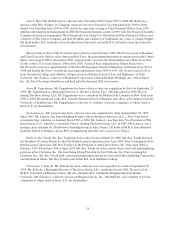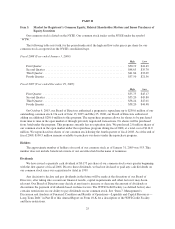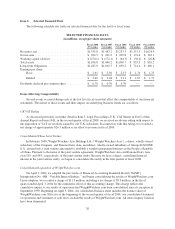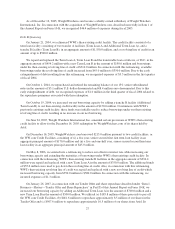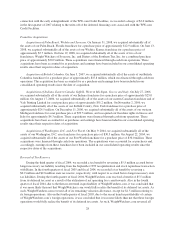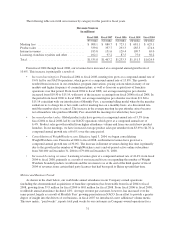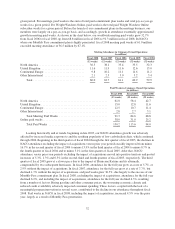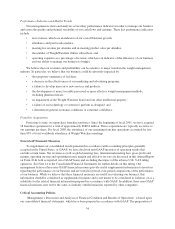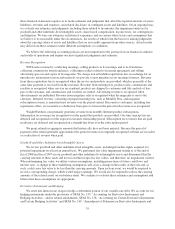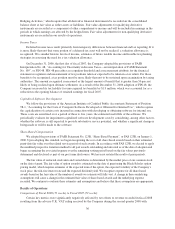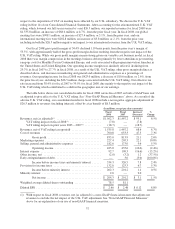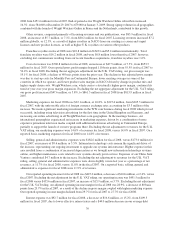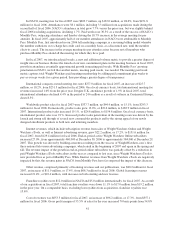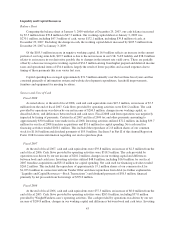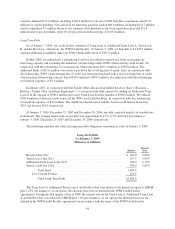WeightWatchers 2008 Annual Report Download - page 47
Download and view the complete annual report
Please find page 47 of the 2008 WeightWatchers annual report below. You can navigate through the pages in the report by either clicking on the pages listed below, or by using the keyword search tool below to find specific information within the annual report.Performance Indicators and Market Trends
Our management reviews and analyzes several key performance indicators in order to manage our business
and assess the quality and potential variability of our cash flows and earnings. These key performance indicators
include:
• net revenues, which are an indicator of our overall business growth;
• attendance and paid weeks metrics;
• meeting fee revenue per attendee and in-meeting product sales per attendee;
• the number of WeightWatchers Online subscribers; and
• operating expenses as a percentage of revenue, which are an indicator of the efficiency of our business
and our ability to manage our business to budget.
We believe that our revenues and profitability can be sensitive to major trends in the weight management
industry. In particular, we believe that our business could be adversely impacted by:
• the temporary emergence of fad diets;
• a decrease in the effectiveness of our marketing and advertising programs;
• a failure to develop innovative new services and products;
• the development of more favorably perceived or more effective weight management methods,
including pharmaceuticals;
• an impairment of the Weight Watchers brand and our other intellectual property;
• a failure of our technology or systems to perform as designed; and
• a downturn in general economic conditions or consumer confidence.
Franchise Acquisitions
From time to time, we repurchase franchise territories. Since the beginning of fiscal 2001, we have acquired
18 franchise operations for a total of approximately $680.8 million. These acquisitions are typically accretive to
our earnings per share. For fiscal 2008, the attendance of our remaining franchise operations accounted for less
than 18% of total worldwide attendance at Weight Watchers meetings.
Non-GAAP Financial Measures
To supplement our consolidated results presented in accordance with accounting principles generally
accepted in the United States, or GAAP, we have disclosed non-GAAP measures of operating results that
exclude certain items. Net revenues as well as global meeting fees, international meeting fees, gross profit and
margin, operating income and operating income margin and effective tax rate are discussed in this Annual Report
on Form 10-K both as reported (on a GAAP basis) and excluding the impact of the adverse U.K. VAT ruling
against us. See Note 14 to the Consolidated Financial Statements for further details on this ruling. Our
management believes these non-GAAP financial measures provide useful supplemental information to investors
regarding the performance of our business and are useful for period-over-period comparisons of the performance
of our business. While we believe that these financial measures are useful in evaluating our business, this
information should be considered as supplemental in nature and is not meant to be considered in isolation, or as a
substitute for the related financial information prepared in accordance with GAAP. In addition, these non-GAAP
financial measures may not be the same as similarly entitled measures reported by other companies.
Critical Accounting Policies
“Management’s Discussion and Analysis of Financial Condition and Results of Operations” is based upon
our consolidated financial statements, which have been prepared in accordance with GAAP. The preparation of
34


